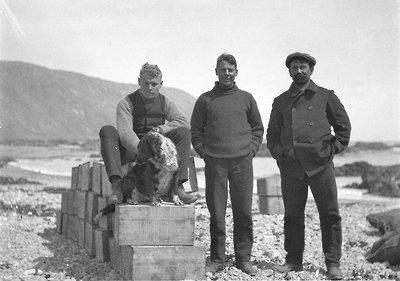Relief
Tutanekai arrived at Macquarie Island on 20 August. Among the passengers were newspaper reporters and the biologist Edgar Waite, who wrote that the journalists were keen to tell the story of starving castaways:
A bearded man, wearing knee-high raw-hide boots, a rough woollen cap, a coarse grey woollen shirt and a coat stitched and restitched to rival Joseph’s famous article of apparel, jumped on board. He looked a picture of manly strength and virility. It was George F Ainsworth … One could not help thinking that the appearance of the man, and that of the men … in the boat, at once discounted the starvation story.
The correspondents noted that the men looked ‘well-fed but palpably weak’, and observed them eating a hash made of elephant seal hearts: ‘It was a dry hash, quite black in colour and disintegrated in the manner of very dry black pudding. Those who were tasting it said it was not bad at all, which was non-committal to say the least. This mess was being washed down by coffee, minus sugar and milk.
The night before Sawyer left on the Tutanekai, Ainsworth, Blake, Hamilton and Sandell gave him a send-off dinner of sea-elephant’s tongue, and opened a precious bottle of claret: it was, wrote Ainsworth, ‘surely the poorest thing of its kind, as far as eatables were concerned, that has ever been tendered to any one.’
The uncertain times were over. ‘From that time onwards,’ wrote Ainsworth, ‘we ate no more elephant meat “straight.” A sheep was killed just as the “Tutanekai” left, and we had roast mutton, scones, butter, jam, fruit and rice for tea. It was a rare treat.’
The four remaining members of the AAE party continued their scientific work, also maintaining the wireless relay station until Aurora relieved them three and a half months later on its way south to collect Mawson and his companions. Just before Aurora’s arrival, Rachel Cohen finally made its appearance, leaving for Hobart on the same day as Aurora arrived — 28November 1913.
On board Rachel Cohen were the sealers who had willingly shared their stores with the beleaguered AAE men: ‘Their many acts of kindness towards us will ever be recalled by the members of the party, and we look upon our harmonious neighbourly association together with feelings of great pleasure,’ wrote Ainsworth.
Also aboard Aurora was a party of three men appointed by the Commonwealth Bureau of Meteorology to continue recording the island’s weather. The bureau’s director, HA Hunt, had determined the work was too important not to continue.
On 5 December 1913 the remaining members of the AAE’s Macquarie Island party — George Ainsworth, Leslie Blake, Harold Hamilton and Charles Sandell — finally departed Macquarie Island. Their reward for their difficult second year would be a trip south to Antarctica.

